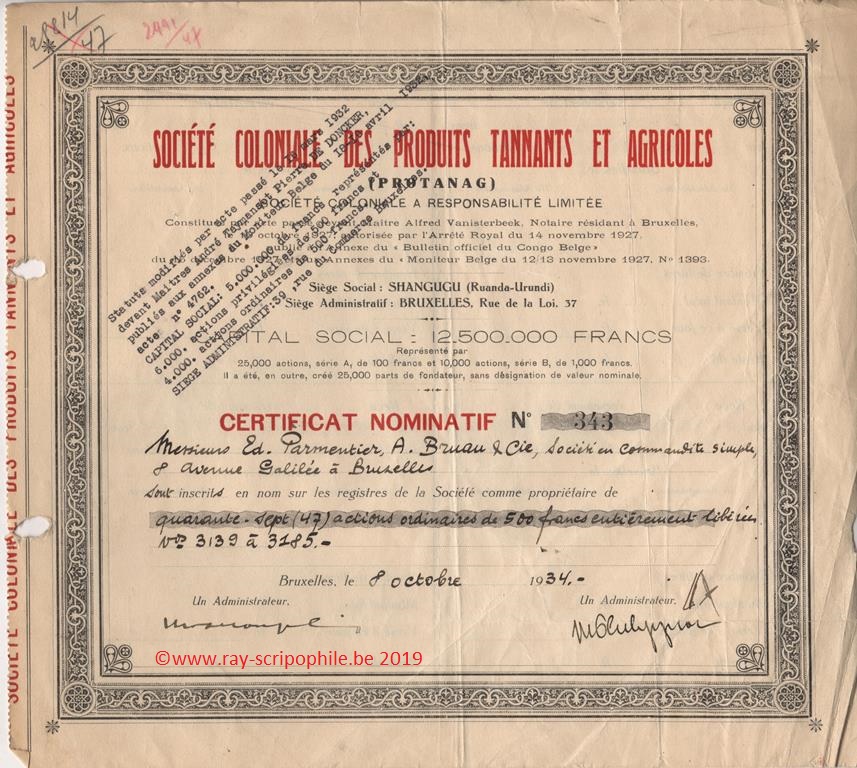SOCIETE COLONIALE DES PRODUITS TANNANTS ET AGRICOLES - PROTANAG S.C.R.L.
Constitution
The Société Coloniale des Produits Tannants et Agricoles "Protanag" was incorporated on October 10, 1927 with a capital of 12.5 million francs represented by 25,000 shares of 100 francs series A and 10,000 of 1,000 francs series B; in addition, 25,000 founder's shares were created without designation of value. The registered office was established in Shangugu (Ruanda-Urundi) and the administrative headquarters in Brussels.
The shares were subscribed by, see opposite:
25% of the subscribed shares were paid up and a sum of 3,125,000 francs was made available to the new company.
As far as the founder's shares are concerned, 12,500 were remitted to Mr. Gottschalck, Mr. Van der Kerken and Mr. Wibier for the contributions described below, to be distributed among them in accordance with their agreements, and the remaining 12,500 shares were divided among the subscribers on the basis of one share for every 1,000 francs and one share for every 10 shares of 100 francs.
Noms MM Philippson et Cie Le Crédit Général du Congo (Crégéco) La S.A. Mutuelle Solvay MM Cassel et Cie La S.A. Banque H. Lambert La Société Internationale de Plantations et de Finances (Sipef) La Compagnie du Congo pour le Commerce et l’Industrie (C.C.C.I.) Charles Liebrechts Isidore Gérard Albert Van Cutsem Max Gottschalck tant pour lui que pour un groupe Rodolphe Wiertz Georges Van der Kerken Albert Wibier | Actions série A 5.000 5.000 5.000 2.000 2.000 1.000 400 100 400 400 2.820 80 600 200 | Actions série B 2.000 2.000 2.000 800 800 400 100 40 160 160 1.128 32 240 80 |
Contribution(s)
Mr. Gottschalck, Mr. Van der Kerken and Mr. Wibier contributed the benefit of an agreement which the Government of Ruanda-Urundi had concluded with them on 12 September 1927 and which included in particular:
- The right to occupy, for twenty years, seven thousand hectares of land in Ruanda (Shangugu territory) with an option to purchase in the event of development, according to the conditions determined in the said agreement and at the price of 25 francs per hectare;
- The right to acquire immediately, at the price of 1,000 francs per hectare, two industrial plots of land, of 5 hectares each, in the Shangugu territory: an industrial plot of 5 hectares in the region of Astrida (Ngozi) and an industrial plot of 5 hectares in the region of Nyanza, intended for the establishment of a factory;
- The right to conclude, under the guarantees provided for in Article 7 of the Convention, arrangements with the natives for the cultivation of tannin trees on their land, in two circles with a radius of 40 km, with Astrida (Ngozi) and Nyanza as their centers.
First Board of Directors
Object
Changes in capital, event(s), shareholding(s)
1930 - At the end of June, the Society was authorized to occupy 2,416 hectares of land. On these expanses, several operating centers were set up: Lusunyu, Nyarushishi, Gashashi and Kibasi (Rwanda). In the areas indicated, the Company acquired from the Colony, the lands of the experimental farm of Dendezi (Rwanda), an exploitation center was established there and trials of cinchona cultivation were carried out (21-(1931 T1) -754/755).
1931 - A financial reorganization had to take place, but it was only in March 1932 that the Company decided to reduce the share capital to 2 million francs and then to increase the capital to 5 million. In addition to the new resources made available to it through the increase, the Company was able to obtain a loan of 3 million francs from the Temporary Crédit Agricole Fund, set up by the Colony, bearing interest at 5% and repayable in 20 years from 1936 (21-(1934 T1) -703/704).
Dissolution and liquidation
After having heard a presentation of the situation of the company, as it resulted from the balance sheet as at 31 December 1935, the EGM decided to dissolve the company early on 27 October 1936, and to liquidate it (30-(1936) -1953 to 58).


